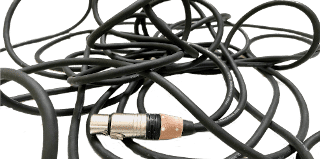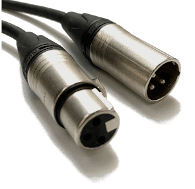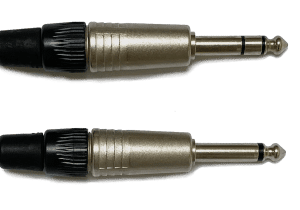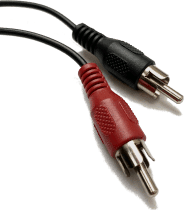Cables & connectors: balanced and unbalanced
When you record audio, it won’t take long before you have to choose between a balanced or an unbalanced cable. What is the difference and which one do you choose? And what does XLR, jack or Tulip mean?

Balanced and unbalanced cables
Unbalanced cables transport the audio signal in the simplest way possible: Through a signal wire and an earth wire. I won’t go into the physics behind it, but that earth wire is needed to transport the audio signal through the cable and at the same time it serves as a protective shield.
Unfortunately, this cable also acts as an antenna that picks up electromagnetic interference. And you can hear this, for example as a hum in your audio recording. The earth wire / protective shield blocks this interference to some extent, but that never works 100%. The longer the cable, the more interference is picked up along the way. An unbalanced cable longer than 3 or 4 meters is therefore not recommended.
In a balanced cable, a technical trick is applied to eliminate the interference that is picked up by the cable. If you want to know more about this ‘technical trick’: we will discuss this later on in this tutorial.
A balanced cable is therefore virtually free of interference, noise and humming. This makes it a better option in many cases, especially if the signal that runs through the cable is very low, as is the case with microphones. That is why most professional audio equipment has balanced inputs and outputs.
Unbalanced cable in a balanced input or vice versa?
That is not a problem, it will work. However, in both cases the connection is unbalanced, so you may hear some noise. You really need a balanced input, output and cable to make a connection balanced.
What really doesn’t work is inserting a stereo cable into a balanced input. Then you probably won’t hear anything at all! 
Different types of connectors
There are many different types of connectors. One is common on microphone cables, the other one is used to connect your headphones. You can often see whether a cable is balanced or unbalanced by looking at the connector. Let’s have a look at the most common audio connectors!
XLR connectors
XLR connectors (see below) are balanced. So an XLR to XLR cable is always balanced. Unless someone has really done their best to turn it into a cable that is unbalanced. But if you buy an XLR-XLR cable in the shop, you can assume that it is balanced. XLR connectors are mainly used with microphone cables.

Jack connectors
A jack connector comes in two flavors: Balanced and unbalanced. You can tell by the black rings on the connector. 1 ring = unbalanced. 2 rings = balanced. This connector is used to connect instruments (e.g. a guitar to an amplifier, or a keyboard to an audio interface).
In a jack to XLR cable, it depends on the jack connector whether that cable is balanced or not. If an unbalanced jack connector is used (so a connector with only one ring), the cable is unbalanced.

A jack connector can also be used as a stereo connector, as is often done with headphones. Then it also has 2 rings, but such a stereo cable is never balanced. Do you want a balanced cable that is also stereo? Then you need two cables: a balanced cable for left and a balanced cable for right.
Jack connectors exist in two sizes. A large jack connector (6.35 mm) and a small jack connector (which is called mini-jack and is 3.5 mm). Mini jack is often found on earbuds that you can connect into your phone. You can also buy converters from mini jack to 6.35 mm jack and vice versa.
Tulip connectors
Besides jack connectors and XLR connectors, there is one more connector you will often encounter: Tulip. It’s used a lot on consumer audio and video equipment. Tulip connectors are always unbalanced.

How does a balanced connection work?
And now for the audio enthusiasts some more technical background information. As we saw, unbalanced cables transport the audio through a signal wire and an ‘earth wire’. Again, we leave out the physics, but that earth wire is needed to transport the audio signal properly.
We already saw that an audio cable serves as an antenna and picks up all kinds of noise and interference. So a trick has been devised to solve this problem. Instead of transporting the audio signal through 1 signal wire and an earth wire from A to B, you let it run through 2 signal wires and an earth wire. And then you ‘phase reverse’ the second signal wire.
Want to know what phase means? Check this tutorial for a more detailed explanation. To summarize it briefly: You can compare it to a pile of sand and a pit. We call the pile signal that is ‘in phase’, the pit we call signal that is ‘180 degrees out of phase’. When the pile of sand is exactly the same size as the pit, you can throw the whole pile into it and they cancel each other out. No more pile, no more pit. This ‘cancelling out’ also happens when you send audio signal through two cables and one is phase reversed in relation to the other. They can exist side by side, but as soon as you add them together (just like the pile of sand in the pit), they cancel each other out.

Ok, so the idea is that you phase reverse the audio signal in one wire and transport it through the cable that way. So one wire carries the pit, the other wire carries the pile.
As soon as the signal arrives in the device, the phase of the ‘pit’ wire is reversed again. So now we have two piles of sand in our metaphor. And then we merge those two piles. If you merge two piles of sand, you just get a bigger pile, they don’t cancel each other out. In the case of an electrical signal, it’s the same thing: you just get a stronger signal, but the signal no longer cancel itself out.
Along the way, you all picked up noise on both wires. So these can be seen as two piles of noise, one on one wire and one on the other. And this is where the magic happens: when the signal arrives in the device, we flip the phase back of the wire that was phase reversed. Because of this, the pile of noise on that wire becomes a pit: you turn it 180 degrees.
So then you have a pile of noise and a pit of noise. When you put that together, it cancels out. And there you go, the noise cancels itself out, so you no longer have any trouble with any interference you have picked up on the way!
Questions? Comments? Please let me know via gijs@audiokickstart.com!

